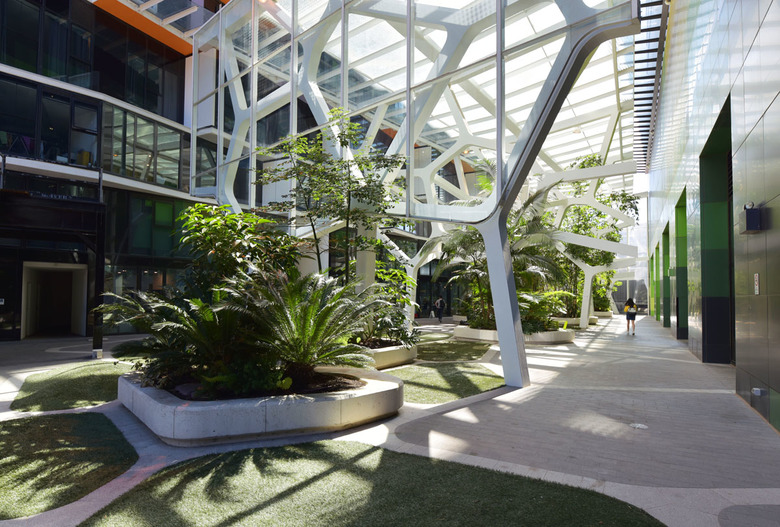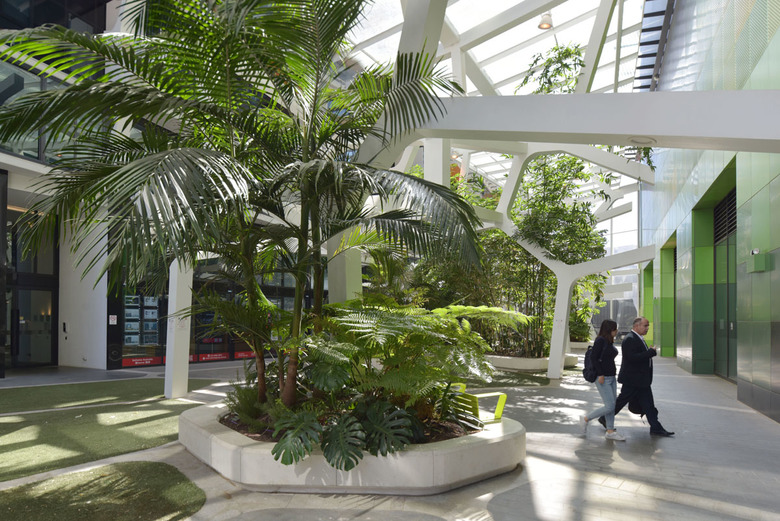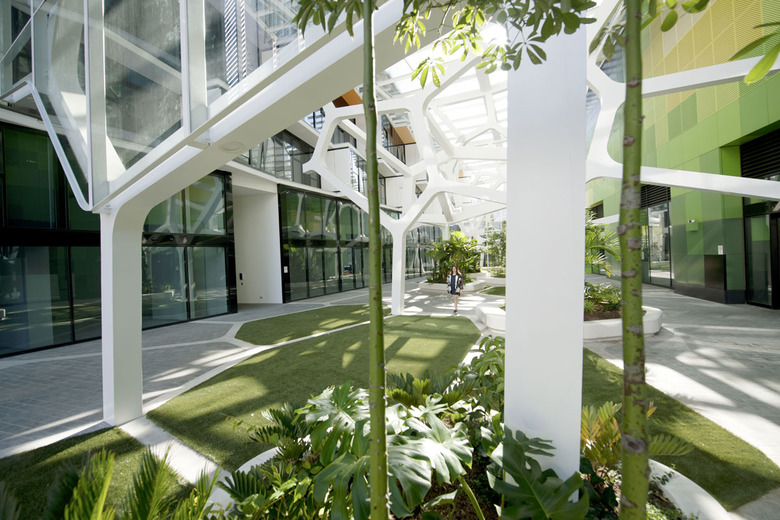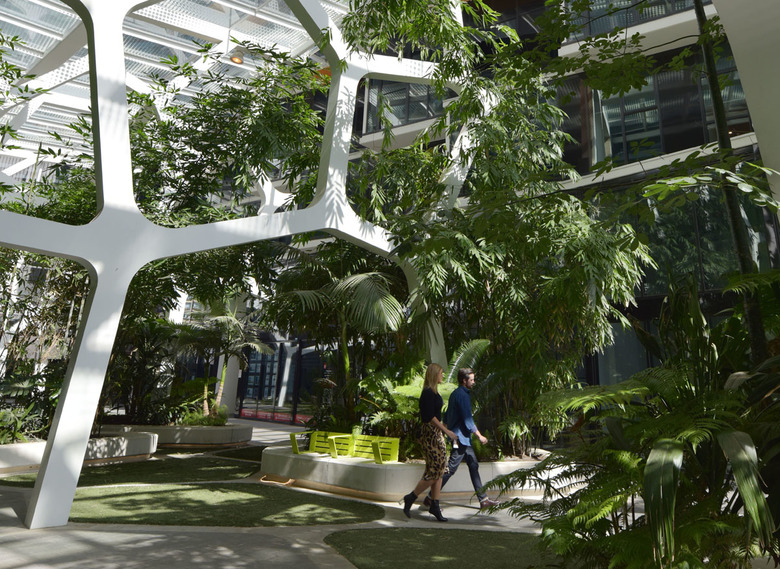Swanston Square Wintergarden
Melbourne is driven with competing forces; we are changing the city forever.
All around the central city, and now the inner urban ring, high- medium- and low-rise projects are evidencing Capital's seemingly insatiable desire for space. Land values are now so inflated, and construction techniques now so swift, that even pencil towers of global slenderness ratio are arising where each floor is just one dwelling. This is not all good news for the inner city.
The other competing force is the pioneering work of the City of Melbourne, seeking a shaded city of green streets, with at least 40% canopy cover, an urban forest to cool our streets and to green our city laneways and networks. Building heights and relationships are firmly back on the agenda.
Pressure on city spaces is increasing, and the inner city microclimate has also changed markedly in 20 years. The City hopes to reduce heat extremes in the city by 4 degrees in future, largely using canopy shade.
The new Wintergarden at Swanston Square evidences these competing forces, and demonstrates one approach to city greening and microclimatic amelioration.
The space accepts the last northern gesture of the Swanston Street axis, framed by tall buildings on either side. With a remarkable, glazed canopy, the design shows what is possible in the interstices of our compact, increasingly dense CBD. It creates wind and rain protection, and a fresh urban type.
The glazed roof by ARM Architects and Irwinconsult, structural engineers, is supported by an unprecedented, complex organic portal system, wrought from the biological vortices of a voronoi, at once a slice through the cells of a plant, or indeed through the bubbles on the head of a beer. The voronoi is continued to the ground plane, and interpreted here as a small rainforest ‘park’, traced from the veins of the cells and infilled, in variety.
The design evokes the tradition of Melbourne's arcades and laneways, the true idea of the Wintergarden, and salvages a delightful space from just the gaps between buildings.
Rush Wright Associates worked to create a rainforest plantings are derived from mixed Australian and exotic flora, while light levels are augmented twice daily in the cool season to ensure appropriate day length and lux levels for healthy plant growth. Light levels were extensively modelled at design stage, and to minimise the need for artificial light. Glass selection, frit, primary and secondary steel were all modelled to check illumination, with the assistance of Inhabit Group, ESD Engineers. Predictions have been audited on site and models recalibrated, validating the software and studies of the design stage. This creates a benchmark for future study.
The project is the first stage of the public realm for this site, where in future the design will extend the Wintergarden from Swanston Street, westwards to Bouverie Street. The owners of the adjoining sites are also already exploring how to extend the design aesthetic to new plaza spaces on the site, and to create the final, integrated network of public spaces. This is a key requirement of the site Masterplan, in review by DELWP as new applications emerge.
On this site we witness policy in action, an investment in healthier, planted outcomes for the smaller spaces of central Melbourne, and a dramatic new benchmark created by private investment in a very constrained commercial environment.
This work is a collaboration between landscape architect and the two architects of the neighbouring towers, with complementary roles in a shared design solution. How to instance the voronoi patterns on the ground, within very tight budgets, and with precision, led us to shop draw every tile at every junction at 1:1, and issuing printed templates to the builders. Some larger elements were lost in the design process, small set down areas for planting and seating, and more complex forms over structure below, but budgets led us elsewhere.
Island seating (creating planters over structure) was initially polished precast, but was executed, instead in situ. It works. We suggested ‘white’ for the portals, and so it became (a nod to the great glasshouses of Europe, perhaps). Lighting is achieved with recessed downlights in the portals, and recessed LED strip lights around the planted islands.
Planting design became a key preoccupation, with a desire to plant a diverse and interesting range of Australian and exotic plants, all capable of withstanding the daily burst of lunchtime sun and the shadowy realms of morning and afternoon, with minimised supplementary light, and natural ventilation.
Self-clinging climbers are already climbing the columns, while experimental trees like Ceiba speciosa already reach for the roof. These are test plantings; part of the lab. This is not without risk, but the dependables will grow well.
It feels lush and green here, a warm city garden, a place where one might choose to be; a big urban lounge even, and a type of back yard. A little dark at times perhaps, but beautifully lit in the evening. It is both interior and exterior, just breezy enough, and nicely protected overhead.
Grocon, and builders Probuild, have sponsored a brave experiment. A unique and memorable space, the wintergarden is a first in a series to be created on the site, forming a benchmark for future city spaces and a laboratory of architectural and landscape design.
The images show growth over time from 2016-2019, and the success of various species that thrive in this constrained city site.
- Apartementsgebouwen
- Gemengd Gebruik
- Landschapsarchitectuur
- Commercial Buildings
- Bedrijfs-en privétuinen
- Jaar
- 2016
- Klant
- Grocon + Probuild ARM Architecture and Studio 505
- Structural engineers
- Irwinconsult
- Specialist design and engineering services
- Inhabit Group
- Constructor innovated Design & Construct delivery
- Probuild
- Engineers
- ESD Engineers
- Architects
- ARM Architects










